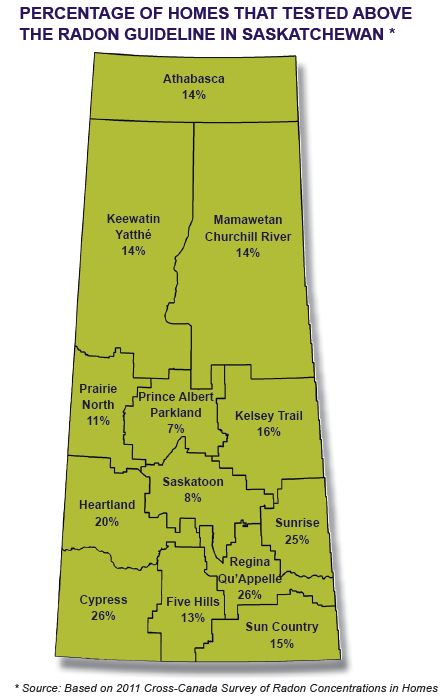We welcome Sandy Hutchison, Regional Radiation Specialist at Health Canada, to the blog to talk about the importance of testing your home for radon.
You may have heard about the harmful health effects of radon gas, but did you know that Saskatchewan has some of the highest rates of elevated radon in homes and buildings in Canada? As a Health Canada Radiation Specialist, I get asked a lot of questions about how people can protect themselves and their families from radon.
What is radon?
Radon is a radioactive gas that occurs naturally when the uranium in soil and rock decays. It is invisible, odourless and tasteless. When radon is released from the ground outside it mixes with fresh air and gets diluted resulting in concentrations too low to be of concern. However, in enclosed spaces, like homes, it can reach high levels and become a health risk to you and your family. Radon enters enclosed spaces through any opening where the house contacts the soil, including cracks in foundation walls and in floor slabs, gaps around service pipes, window casements, floor drains, or cavities inside walls.
How can radon affect my health?
Scientific studies show that radon is the second-leading cause of lung cancer after smoking. Health Canada links 16 per cent of lung cancer cases among Canadians to radon exposure. If you are a smoker (or exposed to second-hand smoke) and exposed to a high level of radon, your risk of getting lung cancer is one in three. If you are a non-smoker, your lifetime lung cancer risk at the same high radon level is one in 20. In both cases, your risk can be reduced by taking steps to mitigate radon entry.
How do I know if I have radon in my house?
The only way to know is to test. All homes and buildings have some radon; the question is how much? Radon levels in two homes built side-by-side can be different for various reasons, including construction practices, the condition of the foundation, and the lifestyle tendencies of a homeowner. Any air pressure change, such as how often you use the bathroom and kitchen exhaust fans, how much you like to open windows, and which heating source you rely on, can impact radon levels.
What are the rates of radon in Saskatchewan homes?
Radon concentrations differ greatly throughout Canada but are usually higher in areas where there is high concentration of uranium in underlying rock and soil. Saskatchewan has some of the highest levels in the country.
Based on Health Canada’s 2012 Cross-Canada Survey of Radon Concentrations in Homes report, 16 per cent of homes in Saskatchewan measured above the radon guideline of 200 becquerels per cubic metre (200 Bq/m3). In certain areas of the province, for example in the Regina-Qu’Appelle, Cypress and Sunrise Health Regions, the rate is much higher -- up to 26 per cent, which is one in four homes. In comparison, the Canadian average is seven per cent. The map [below] will give you an idea of the percentage of homes that tested above the radon guideline in Saskatchewan communities. But I cannot stress enough, the only way to know how much radon is in your house is to test.
How do I test for radon?
Radon test devices can be purchased from retailers, health organizations or certified professionals. If you do it yourself, please follow the directions included in the kit. Health Canada recommends placing the detector in the lowest level of your home that is occupied for at least four hours per day. Testing for a minimum of three months is considered long-term and will better represent your annual average to compare to the guideline.
You can also hire a certified radon measurement professional to complete the test. Health Canada recognizes the Canadian certification program, Canadian National Radon Proficiency Program (C-NRPP). Lists of certified Canadian measurement and mitigation professionals are available through C-NRPP.
How do I fix my radon problem?
There are a number of ways to reduce radon in your home, but the most common and effective way is by installing an active soil depressurization system, which uses a pipe in contact with the soil and a radon fan to move the gas outside before it forces its way into your home. Airtight seals on exposed soil, sump pits, floor drains, floor-to-wall joints and other openings in contact with the soil are important steps to an effective system.
If your house tests over the guideline (200 Bq/m3) Health Canada recommends contacting a C-NRPP certified radon professional to determine the most effective way to reduce the radon level in your home.
About the author: Sandy Hutchison is a Health Canada Regional Radiation Specialist in Manitoba-Saskatchewan. He has been raising awareness of radon through non-government organisations and industry partnerships, as well as through media and public outreach events since 2008. Sandy works continuously to find new opportunities to spread the radon message, “The only way to know is to test.”
For more information:
Additional Information from SRC
- Now is a great time to test for radon! In Saskatchewan, you can buy a radon test kit online from the Lung Association of Saskatchewan and it’s analyzed locally by SRC Environmental Analytical Laboratories.
- The Take Action on Radon Coalition Saskatchewan recently distributed over 300 radon test kits to public and Catholic schools in Saskatoon, Sask. as part of the Little Lungs campaign, to raise awareness about testing homes for radon.
- Video - Radon: What is it and how to test your home
- Article - Are high levels of radon lurking in your basement?
